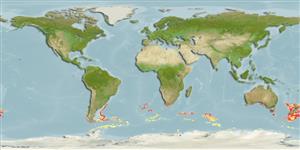>
Zeiformes (Dories) >
Oreosomatidae (Oreos) > Pseudocyttinae
Etymology: Pseudocyttus: Greek, pseudes = false + Greek, kyttaros, kytos = a convex cavity.
Environment: milieu / climate zone / depth range / distribution range
Ecologia
marino batidemersale; oceanodromo (Ref. 51243); distribuzione batimetrica 400 - 1500 m (Ref. 5194), usually 900 - 1100 m (Ref. 36731). Deep-water; 34°S - 67°S, 90°W - 176°W (Ref. 27159)
Southwest Atlantic: off Uruguay to Argentina and the Falklands. Southeast Atlantic: Namibia to South Africa, including the northern part of Walvis Ridge (Ref. 6545). South Pacific: off southern Chile, Bellingshausen and Australian-Antarctic Basin to New Zealand, New South Wales and Tasmania, Australia and the Kerguelen Islands.
Length at first maturity / Size / Peso / Age
Maturity: Lm 40.0 range ? - 41 cm
Max length : 68.0 cm TL maschio/sesso non determinato; (Ref. 58312); common length : 40.0 cm TL maschio/sesso non determinato; (Ref. 9258); peso massimo pubblicato: 5.0 kg (Ref. 6390); Età massima riportata: 100 anni (Ref. 27140)
Spine dorsali (totale): 5 - 7; Raggi dorsali molli (totale): 33-36; Spine anali 2-3; Raggi anali molli: 31 - 34; Vertebre: 40 - 43. First dorsal spine longer than second dorsal spine. Opercles fully scaled (Ref. 27159).
Female adult chocolate brown in color with darker fins; prejuveniles silvery with numerous dark spots of various sizes which become larger with age (Ref. 6548).
Inhabit continental slopes of all southern continents (Ref. 6545). Adults found near the bottom; juveniles near the surface, usually in association with krill (Ref. 5194). Feed mainly on salps (Ref. 27150). Eggs float near the sea surface and larvae also inhabit surface waters (Ref. 6390). There is no vertical migration during the day or night (Ref. 27150).
Displays seasonally synchronised reproduction (Ref. 6390).
Heemstra, P.C., 1990. Oreosomatidae. p. 226-228. In O. Gon and P.C. Heemstra (eds.) Fishes of the Southern Ocean. J.L.B. Smith Institute of Ichthyology, Grahamstown, South Africa. (Ref. 5194)
IUCN Red List Status (Ref. 130435)
Threat to humans
Harmless
Human uses
Pesca: commerciale
Informazioni ulteriori
CollaboratoriImmaginiStamps, Coins Misc.SuoniCiguateraVelocitàModalità di nuotoArea branchialeOtolithsCervelliVista
Strumenti
Special reports
Download XML
Fonti Internet
Estimates based on models
Preferred temperature (Ref.
123201): 2.1 - 6.1, mean 4.2 °C (based on 189 cells).
Phylogenetic diversity index (Ref.
82804): PD
50 = 1.0010 [Uniqueness, from 0.5 = low to 2.0 = high].
Bayesian length-weight: a=0.01995 (0.00816 - 0.04876), b=3.00 (2.79 - 3.21), in cm total length, based on LWR estimates for this (Sub)family-body shape (Ref.
93245).
Trophic level (Ref.
69278): 3.6 ±0.47 se; based on food items.
Resilienza (Ref.
120179): Molto basso, tempo minimo di raddoppiamento della popolazione più di 14 anni (K=0.07; tmax=100; tm=31; Fec=6,000).
Fishing Vulnerability (Ref.
59153): High to very high vulnerability (72 of 100).
Climate Vulnerability (Ref.
125649): Moderate vulnerability (39 of 100).
Nutrients (Ref.
124155): Calcium = 16.2 [8.5, 36.6] mg/100g; Iron = 0.416 [0.153, 0.905] mg/100g; Protein = 17.2 [14.6, 20.0] %; Omega3 = 0.332 [0.167, 0.702] g/100g; Selenium = 24.3 [9.3, 71.5] μg/100g; VitaminA = 11.1 [1.8, 67.9] μg/100g; Zinc = 0.335 [0.207, 0.526] mg/100g (wet weight);
